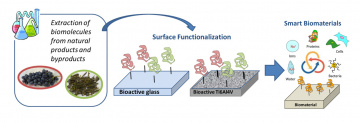Surface modification of biomaterials
Biomaterials (titanium an titanium alloys, bioglasses, hydroxyapatite) with different topography, crystalline structure, microstructure and chemical composition are produced by surface treatments (chemical etching, structuring by laser or e-beam, functionalization with biomolecules): the final goal is a better biological outcome that means an enhanced ability of tissue integration, a reduced risk of infection and a modulation of the inflammatory response. Functionalization is performed with biomolecules of natural origin. The surface are characterized by means of SEM-EDS, XRD, Raman Spectroscopy, FTIR, UV-VIS, confocal profiolmetry and fluorescence microscopy (equipment acquired by the interdipartimental center).
Cell and bacteria cultures (biofilm growth) are performed on the different surfaces and the relationship with the topographic, structural, microstructural and chemical features is investigated.

Relevant publications:
Ferraris S., Yamaguchi S., Barbani N., Cazzola M., Cristallini C., Miola M., Vernè E., Spriano S. Bioactive materials: In vitro investigation of different mechanisms of hydroxyapatite precipitation. Acta Biomat Vol. 102, pp. 468-480, 2020 https://iris.polito.it/handle/11583/2778699#.XjKaAzJKh1s
Ferraris S., Warchomicka F., Iranshahi F., Rimondini L., Cochis A., Spriano S. Electron Beam Structuring of Ti6Al4V: New Insights on the Metal Surface Properties Influencing the Bacterial Adhesion Materials, vol. 13, pp. 409, 2020
Cazzola M, Ferraris S, Allizond V, Bertea CM, Novara C, Cochis A, Geobaldo F, Bistolfi A, Cuffini AM, Rimondini L, Banche G, Spriano S Grafting of the peppermint essential oil to a chemically treated Ti6Al4V alloy to counteract the bacterial adhesion. Surf. Coat. Tech.vol. 378, pp. 125011, 2019 https://iris.polito.it/handle/11583/2778991#.XjKaaTJKh1s
